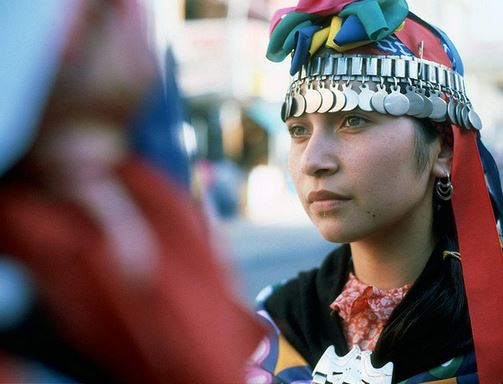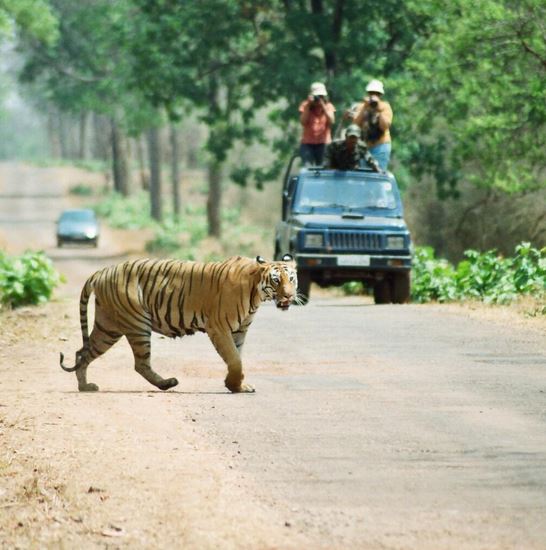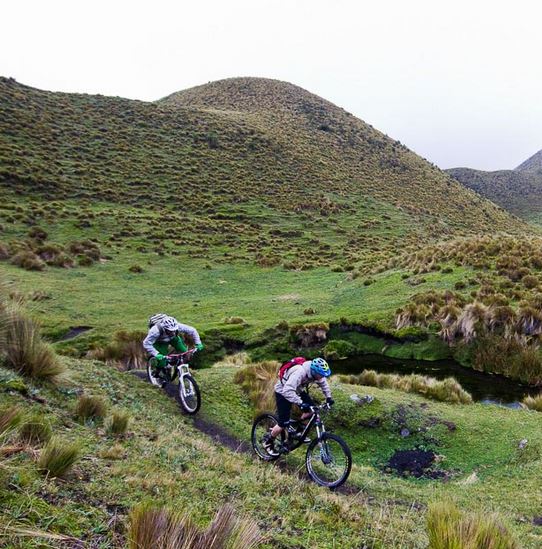
A member of the Mapuche community in Chile.
Traditional communities around the globe are disappearing with alarming speed. We have already lost so much as villagers and whole groups have had to abandon their rural communities and villages to move to cities to find work to support their families. The loss in many cases is irretrievable. Gone are their traditions, their knowledge and wisdom, their stories and even their languages in many cases. To begin to redress this situation, we can bring those trying to hold onto their traditional ways into the international tourism equation, and by educating our guests about the value of these communities to our collective, global well being.
1. Muang La, Laos – Includes Khmu, Lao Loum, Hmong and other minor ethnic groups
There are about 130 distinctive indigenous tribes in Laos. The provincial capital of Oudomxai is home to about 14 different ethnic groups, but the exact proportions are still not precisely known. In this province, the town of Muang La and its surrounding villages have some of Lao’s most authentic and still untouched hill tribe communities. Here in the extraordinary landscapes of luscious hills, steamy forests and verdant rice paddy fields, you still encounter villages and settlements where people continue to dress in jewel-colored traditional clothing, decorated with cloth and antique coins passed down through generations. Explore these traditional communities on our Indochina journey.
2. Huilo Huilo, Chile – Mapuche
This area is known for indigenous groups, known collectively as the Mapuche. The wide-ranging ethnic groups share a common social, religious and economic structure, and a common linguistic heritage. They were so spread out that they were able to resist the Spanish invaders for 300 years. They were never conquered. The Mapuche community today is working to maintain a proud heritage through a number of initiatives, including workshops for local students that focus on their traditional art, painting, dance, wood carving, music, and baking and chocolate-making. You can meet and interact with members of this fascinating and proud culture during an adventure such as in our Chile & the Culture of the Mapuche.
3. Zuleta, Ecuador – Caranqui
Situated in the spectacular Northern Andes, Hacienda Zuleta dates from the late 16th century. It is a colonial working farm of some 4,000 acres that has for more than a century has belonged to the family of Mr. Galo Plaza Lasso, a former president of Ecuador. Before the hacienda existed, the region’s original inhabitants were the peace-loving Caranquis, an agrarian-based culture that thrived with the rich in volcanic soils. They lived there from about 800 A.D. until the arrival of the Incas in the late 1470’s. Within the hacienda’s grounds, 130 Caranqui Mounds were discovered that were constructed around 1200 A.D. This is one of the best-preserved Caranqui archaeological sites in Ecuador. Research here has unveiled some of the ancient customs of the first cultures to inhabit the area. The goal of the project is create a museum and to provide the descendants information about their origins and the culture of their ancestors. You can explore this area on our Ecuador Highlands.
4. Bwindi Impenetrable Forest, Uganda – Batwa People of the Forest
The Batwa have always been the people of the forest. But when the Bwindi Impenetrable Forest became a national park in 1991, this community was forced out of their traditional homeland for a number of reasons – conservation, the rare highland gorillas, tourism and business interests. They became, in effect, conservation refugees. They may be part of between 900,000 and 14.4 million African people who have been displaced due to conservation, according to Charles Geiser and Ragendra de Sousa, sociology academics at Cornell University. The tragic irony is that the Batwa’s forest lifestyle has always been in tune with conservation of the environment and of the gorillas. The Batwa Experience is an eco-tourism initiative established by an American doctor and his wife, who sought to save this ancient culture from the brink of extinction. The project, Batwa Development Program, works with the Batwa community to try to ensure that their indigenous rights are respected and they also benefit from the forest being a national park and a tourism site. The Batwa cultural experience was created to educate their children and to share their amazing heritage and traditions with the world. Here, you have the opportunity to hike through the forest with a Batwa guide, who shares his knowledge of the forest; or, visit a traditional Batwa homestead and learn from the women how to prepare, cook and serve a meal; or, talk to a medicine man about the medicinal properties of the forest flora; and hear ancient legends and traditional songs. This experience can be included in a Uganda adventure itinerary.
5. Kaokoland, Namibia – Himba
The Himba people share a common ethnic origin with the Herero tribe, having split from the main Herero group on the Namibia/Botswana border. Unlike many indigenous groups in Africa, the Himba have managed to maintain much of their traditional lifestyle, perhaps owing to the fact that their lands are so harsh and inhospitable that not many others want anything to do with it. Of the Himba, Tjimba and other Herero people, who inhabit Namibia’s remote northwestern Kunene Region, the largest group are the Himba, semi-nomads, who live in scattered settlements throughout the region. For many centuries, they have lived in relative isolation. They are a tall, slender and statuesque people, characterized especially by their proud yet friendly bearing. The women especially are noted for their unusual sculptural beauty, enhanced by intricate hairstyles and traditional adornments. They rub their bodies with red ochre and fat, a treatment that protects their skins against the harsh desert climate. The homes are simple, cone-shaped structures of saplings, bound together with palm leaves and plastered with mud and dung. The men build the structures, while the women mix the clay and do the plastering. A fire burns in the headman’s hut day and night, to keep away insects and provide light and heating. A family may move from one home to another several times a year to seek grazing for their goats and cattle. Men, women and children adorn themselves with necklaces, bracelets, anklets and belts made from iron and shell beads. With their unusual and striking designs, these items have gained a commercial value and are being produced on a small scale for the urban market. You can share a respectful encounter with these remarkable people on our Namibia & Botswana journey.

A shot from the Tadoba Andhari Reserve in Maharashtra, India
Did you know that the first wildlife sanctuary ever created came around 300 BC when King Devanampiya Tissa of Sri Lanka created a wildlife sanctuary near Mihintale, where he banned hunting and tree cutting. In the US In the early 20th century, President Teddy Roosevelt proclaimed the first American sanctuary at Pelican Island National Wildlife Refuge in the Indian River Lagoon, Florida, for the protection of egrets. Their striking plumage was in high demand for ladies’ hats.
We selected five vital wildlife sanctuaries that we believe are worth the experience.

Biking in the highlands of Ecuador
Bicycles were introduced in the mid-19th Century in Europe. Today, they outnumber cars by something like two to one around the world. They serve as the primary means of transportation for millions of people. Most Americans ride bikes for recreation, but some areas such as Southern California are more conducive to biking as part of daily life.
We looked for five stunning settings where biking excursions offer remarkable rewards to the adventurous traveler.
Wine enthusiasts are always delighted to discover new wines in unexpected places. We looked at some locales that you might not expect to find an active wine industry. Where have you found your favorites?
Thailand: Bangkok
Thailand is not usually on the top of wine destination choices, but Thailand is, indeed, growing their own wines and, doing so in different and impressive ways, adding their own ideas such as floating vineyards. GranMonte Vineyard is among the newest and most cutting-edge wine experiences that have emerged in Thailand in the last 12 – 18 months. It was the vision of Visooth Lohitnavy’s passion for wine. In 1999, Visooth saw a 12-hectare plot of land in the Northeast Thailand, once a cornfield and cashew plantation, as the ideal locale for his new enterprise. You can experience this new venture, on our Thailand & Cambodia.
Israel: Galilee and Golan Mountains
Israel is definitely tops when it comes to astonishing ancient ruins and a wealth of religious sites, but wine? Most of the developments in the wine industry here have evolved over the last two decades. In the 1990s, seven wineries began to change the wine industry here. Two of Israel’s wine regions are the mountainous regions of Galilee and Golan Mountains, while other wines can be found in Samson and Negev. Varieties include classic Bordeaux grapes of Merlot, Cabernet Sauvignon. You can incorporate vineyard experiences in adventures such as Israel, Turkey & Morocco: Foundations of Faith. This fascinating journey was one of a National Geographic Traveler’s 2012 “50 Tours of a Lifetime.”
India: Punjab, Tamil Nadu, Karnataka
India is another stellar destination that is not known as a principal wine producer. But India’s wines are beginning to gain recognition at more international wine competitions. Wine producing regions are developing from Punjab to Tamil Nadu. The established regions are in Maharashtra including Nashik, Sangli, Sholapur, Satara, Ahmednagar and Pune. In the state of Karnataka, you’ll find wine-growing regions in the foothills of the Nandi Hills of Bangalore. In Pune resides the first and infamous winery Chateau Indage, the current bastion of Indian produced wine. You can add a wine stop in our India – Gujarat & Karnataka journey.
Argentina: Patagonia
Wine, Patagonia… really? Yes, you will find some of the southernmost vineyards on the planet here. And the region is just 400 miles south of Argentina’s most famous vineyards in Mendoza. Patagonia’s dry, breezy climate sees just seven inches of rainfall a year, which means the grapes are free of diseases such as powdery mildew. Because of the extremes in temperatures from day to night, the grapes ripen slowly, preserving sugar-acidity balance. Patagonia has two primary regions for wine growing – Neuquén and Río Negro. In Neuquén, a pioneering winery, Bodega del Fin del Mundo, earns medals for its Cabernet, Merlot and Malbec blends. On the Patagonian plateau, the Río Negro region is suited to white varieties like Traminer and Riesling, as well as Merlot, Malbec and Pinot Noir. Craft your own Argentina experience and add a Patagonian wine stop with a Custom Argentina Tour.
China: Shandong, Hebei, Tianjin, Ningxia & Shanxi
You may be surprised to know that China is one of the top 10 wine-producing countries in the world. China’s wine regions spread across the breadth of the country, from the humid, monsoonal east coast areas of Shandong, Hebei and Tianjin, inland to the regions of Ningxia and Shanxi. Today, many international wine companies such as Moet Hennessy and Remy Cointreau are taking strong interest in China. And with the potential size of the Chinese market, it’s no wonder. But it will be some time before you see many Chinese wines on your local shelves. According to one wine writer, “China is close on the heels of Old world and New world wines alike.” Explore China with adventures such as China’s Captivating Visions & Timeless Horizons and discover Chinese wines along the way.
Surfing is a lifelong passion for many; and nearly everyone from 8 to 80 can participate. Serious surfers have their favorite places and secret spots they return to again and again. They also have a bucket list of locations around the globe they would love to go to ride the waves. We thought we’d make our own bucket list and looked at locations that might surprise some of you.